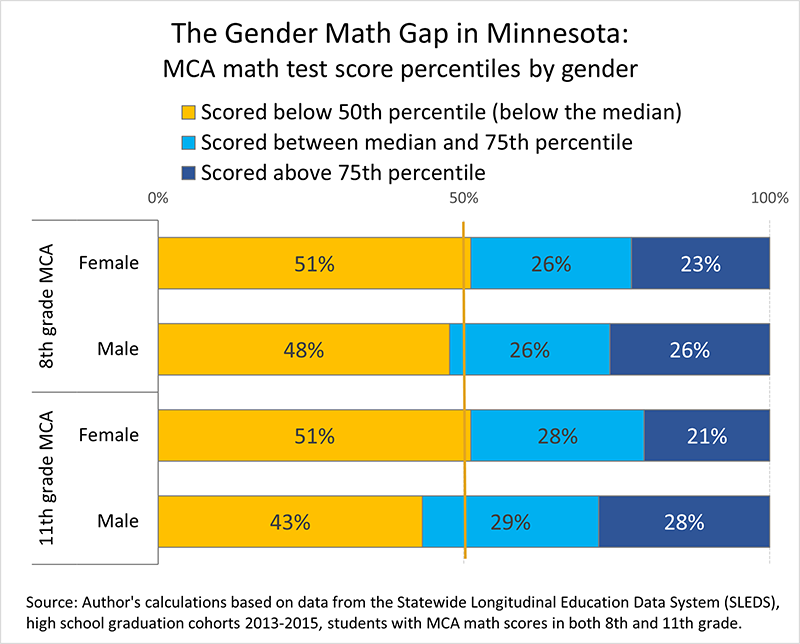The Gender Math Gap and its Effects on Earnings

by Alessia Leibert
March 2023
Minnesota ranks fourth lowest in the nation for percentage of women in poverty, and 12th highest for the percent of women with a bachelor's degree or higher credential. Despite these accomplishments, female workers in Minnesota experience lower earnings compared to their male peers.
A recent study published by the Minnesota Department of Employment and Economic Development, The Gender Math Gap and its Effects on Earnings analyzes the role of math proficiency in contributing to gender pay gaps in Minnesota. Specifically, it compares female high school graduates to their male peers to determine if a gender math gap exists, how it influences educational choices in secondary and postsecondary school, and how it contributes to gender wage disparities years after high school.
The study tracks employment history, including industry and wage information, for 142,9091 individuals who graduated from a Minnesota public high school between June 2013 and June 2015. Since we know their high school experiences and employment histories, we can identify the earliest points in life when gender wage gaps emerge and formulate hypotheses on how math proficiency contributes to their formation. This evidence can help to craft policy responses to address the problem.
Is there a math gap by gender?
We have Minnesota Comprehensive Assessment (MCA) math test scores from 8th and 11th grade for 130,018 of the 142,909 Minnesota public high school graduates we tracked for this report. Standardized math scores in 8th grade show that a bigger share of girls scored below the median than boys, 51% versus 48% (Figure 1).
Figure 1

The gap in the same group of students is even larger in eleventh grade, with 51% of girls scoring below the median to 43% of boys, and 21% scoring above the seventy-fifth percentile versus 28% among boys. This indicates a deterioration in math skills among girls relative to boys.
Why does this gap matter? Scoring above the median in eighth grade math increases the likelihood of entering accelerated math paths, allowing students to take Calculus and AP Statistics & Trigonometry. It also increases the likelihood of obtaining a high score in the math portion of the ACT, the most widely administered college entrance exam in the U.S. College-readiness in math, in turn, increases the probability of enrolling and completing majors in STEM, business, and Registered Nursing, which tend to be higher paid than others.
Main research findings
Our analysis found that females earned 92% of the wage earned by their male peers six years after high school graduation (Figure 2). Given that $18.85 is the family-sustaining wage (see cost of living tool), it is clear that the transition from high school to career is less successful for females despite the fact that they hold more education: 65% of females represented in this graph had completed a postsecondary credential six years after graduating high school versus 52% of males.
Figure 2

We also found that:
- Math scores in 8th and 11th grade are a strong predictor of future earnings and contribute to the gender wage gap. However, other factors have an even greater impact on the gap. For example, the large gender imbalance in choice of Career and Technical Education (CTE) courses, with boys being more likely than girls to take courses that boost math readiness, has a large effect on the gender wage gap. This suggests that lower readiness in math, or negative attitudes towards math, might have pushed girls towards careers and postsecondary majors with lower labor market value than those chosen by boys.
- If CTE course choices are as good a barometer of future occupational choices as they appear to be from our analysis, gender differences in math readiness or attitudes towards math early in life appear to have contributed to occupational segregation, a known leading cause of gender wage gaps. This segregation is already evident from 9th grade, when students start exploring careers and curriculum choices start to diverge dramatically by gender. Therefore, waiting until 12th grade to try to equalize choice of postsecondary major is too late, because paths toward career preparation begin to diverge by gender much sooner.
- Males, thanks primarily to CTE programs in the skilled trades, achieve a family-sustaining wage by age 24 even when they score below the median in 11th grade math and even without attaining a postsecondary credential. Boys' more frequent choice of skills training in high-paying fields while in high school offers them multiple paths to a living wage even if their math preparation is lacking. Examples of high-paying male-dominated careers not requiring any postsecondary education are construction workers and supervisors, welders, and automotive repairers; industry-recognized credentials in these fields can be acquired through CTE elective courses. In contrast, females rely more heavily on postsecondary education, which often hinges upon college-readiness in math. This is how the gender math gap takes a big bite out of women's earnings.
- The biggest contributors to the gender wage gap in Minnesota are gender differences in CTE course-taking (reflecting early career choices), postsecondary major (reflecting occupational segregation), and industry of employment (reflecting industry segregation). The distinction between factors that emerge before entering the labor market, like choice of elective courses in high school or college major, and factors that emerge after entering the labor market, like industry of employment six years after high school is an important one. While major is typically a voluntary choice, industry of employment is the result of job sorting mechanisms in the labor market that individual job seekers have less control over. Finding an association between industry and gender pay gaps, while simultaneously holding major constant, signals that women are less successful than men at entering jobs where their educational investments are fully rewarded. This is a problem of equal opportunities in the labor market.
- The gender pay gap is higher in Greater Minnesota than in the Twin Cities Metro. Furthermore, the gender pay gap in the Metro is entirely eliminated when we account for other characteristics that affect earnings, while in Greater Minnesota 2.9% of the gap remains unexplained. Unexplained factors might indicate discrimination in the workplace. This result suggests that the Metro labor market is more favorable to working women than the Greater Minnesota labor market.
Equity implications and policy recommendations
These findings have strong equity implications. Since females are less likely to access job skills training in high school through CTE and instead wait until postsecondary school, they are more likely to take on a financial burden for education. Every time a category of workers has to shoulder more of the cost of skills training than another category (e.g., females versus males) inequalities will inevitably emerge in the labor market. A category can be defined by gender, race, age, disability, or any other characteristic.
Here is a summary of policy recommendations to address each factor leading to gender pay gaps in Minnesota:
- Factor 1: Gender math gaps. Since math gaps feed into the overall gender pay gap, policies aimed at improving math skills among girls in middle and high school to catch up with boys are warranted. Girls should be informed of the importance of math readiness to enter careers in health care and business that require more quantitative skills than students might realize.
- Factor 2: Males' dominance in high-value CTE courses. Breaking this dominance requires rebalancing the gender composition of CTE programs in high schools. Achieving this goal requires multiple interventions. First, improving career counseling services to promote high-value CTE programs to female students and their parents. Second, improving the learning environment for girls, for example by creating girls-only welding classrooms to help girls imagine themselves in these careers and boost their self-confidence. Third, expand CTE curriculum towards emerging careers, outside the traditional skilled trades, that don't require a four-year degree and are gender-neutral. The curriculum should be designed to give students with diverse math abilities equal opportunity to receive rigorous STEM-related contextual learning.
- Factor 3: More postsecondary education is not a way out of gender wage gaps; in fact, the gap increases when we take differences in postsecondary education into account. Females are being pushed towards investments in postsecondary school to match the earnings of males because they have fewer direct paths from high school to financially viable careers. Women have to complete college at higher rates than men, often to the point of being over-educated for their career of choice, to match the earnings of men. This is a consequence of systemic factors, such as social norms pushing girls towards careers requiring college and low wages in female-dominated industries. To help fix this problem, girls should be more equally represented in high-value CTE courses with work-based learning opportunities in fields not requiring a four-year degree. If these programs do not yet exist at individual high schools, they should be developed in partnership with local employers. However, changes to CTE would only be one small solution to a much larger problem.
- Factor 4: Over-representation of males in high-pay postsecondary majors. Fixing the gender math gap can help rebalance the gender composition of postsecondary majors only if accompanied by other policies or initiatives to help girls improve their expectations of success in these careers, challenging the stereotypical gender roles that push them towards low-wage occupations and industries. Awarding scholarships or partial tuition reimbursement to females who pursue high-demand, non-traditional majors would also contribute to rebalancing the gender composition of these programs and females' representation in related occupations.
- Factor 5: Over-representation of males in high-pay industries. This factor, larger than any other, lies squarely in the responsibility of employers. Policies aimed at strengthening the enforcement of equal pay laws are essential to address this issue, as well as initiatives aimed at helping employers identify and remove gender bias in hiring and promotion.
Although equalizing math preparedness may seem like a drop in the bucket compared to the daunting systemic forces that produce gender pay gaps, it would improve women's chances to prepare for gainful employment while in high school or complete credentials in financially viable fields. Therefore, it deserves to be part of a workforce equity agenda.
Read full article.
1The dataset consists of 142,909 individuals who graduated from a Minnesota public high school between June 2013 and June 2015. High school enrollment records were merged with postsecondary student records and Minnesota Unemployment Insurance wage records from the Statewide Longitudinal Education Data System (SLEDS).


